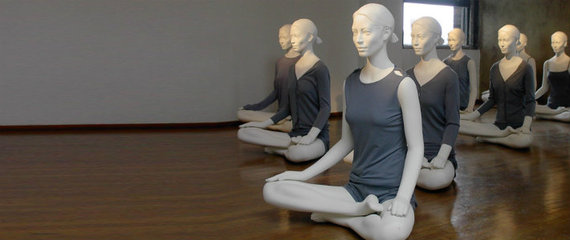Yesterday I was the only black person in my yoga class. As I scanned the room, I also noticed I was also the largest, and I wear size 10. But I am accustomed to this scene. My uniqueness in this crowd is not an exception. It's the norm. I have practiced yoga across the country, in urban studios and at retreats in exotic places, and I am often the lone brown-skinned person -- a speck amidst a sea of ponytails. It's never bothered me, but in my recent quest to get more brown people health literate and active, I am increasingly frustrated by the overwhelming perception that yoga is a sedentary and elitist activity suitable primarily for thin, wiry women of fair hue who can contort their bodies into unimaginable shapes. The truth is yoga is simply about moving and breathing, and the people who can benefit from it most but access it least look like me. Black people, men and women alike, have the highest rates of chronic, preventable diseases like heart disease, high blood pressure, obesity and cancer, yet we are least likely to practice yoga. This mismatch is about both perception and limited access and I want to help change that.
Changing community perceptions about yoga is becoming an obsession for me. I practice medicine in Southeast Washington, D.C.-- a community that desperately needs yoga. Like many urban areas across the country, Southeast, D.C. is a community with abundant chronic diseases, mental disorders and poverty. Where there is poverty, there is stress and where there is stress there is disease. Stress is one of the greatest contributors to high blood pressure and heart disease and consistently practicing yoga reduces stress. It also alters mood and outlook and this impact on the nervous system reduces inflammation throughout the body. This nervous system benefit is critical because chronic inflammation inside the body contributes to development of disease. These physical and other mental health benefits of yoga have been well-established in research studies and yoga is endorsed by NIH as a complementary medicine approach.
Communities like Southeast D.C. can benefit greatly from yoga, but for these benefits to be realized we must first improve awareness and increase access to yoga throughout these neighborhoods. In 2011, while on faculty at HU, in conjunction with Buddha B Yoga, I conducted a pilot study (unpublished) to understand poor, black women's perceptions about yoga. Although the study enrolled only 50 women, it highlighted important information we must address if yoga is to become accepted and mainstream in the black community. Noteworthy findings included:
- 74 percent had never tried yoga, 40 percent of whom said they couldn't afford it
- 44 percent agreed with or were neutral about the statement, "Poor people don't practice yoga"
- 20 percent believed black people don't practice yoga
- 43 percent believed yoga is a religion
- 64 percent thought practicing yoga required a lot of training
- 53 percent felt yoga was not physically difficult
- Reasons for not practicing yoga included: not knowing where to go to practice yoga, never being invited to practice yoga, not having access to a yoga teacher and never thinking of yoga as an option for them
As we informed the women in the study and as Anacostia Yogi describes in her recent blog, yoga is not monolithic. The practice can serve many purposes toward achieving health and wellness. Yoga can help prevent and remedy chronic diseases. This is why we must drastically expand the landscape of yoga practitioners, increase access to yoga practice and address misperceptions about yoga among those who can benefit from it.
If we are to succeed in diversifying the field of yoga practitioners, efforts like those of the CWC, which incorporates the concepts of suspendeds for those who can't afford to practice, should be supported to improve access to yoga in low-income neighborhoods. Equally as important, we must educate diverse communities about yoga and dismiss the notion that it is a sedentary, coma-inducing activity. The practice accommodates all physical abilities and allows a novice with little physical strength to practice alongside the neighborhood jock. Yoga can be physically demanding and push you to your physical edge. But don't take my word for this. Watch TanoMazi do a handstand or Mimi Rieger lead a Rocket yoga class. Grab a mat and give it a try.
*Buddha B Yoga should be acknowledged for extending an amazing act of kindness after our yoga study. They offered one-year free yoga classes to all women participating in the research study.
